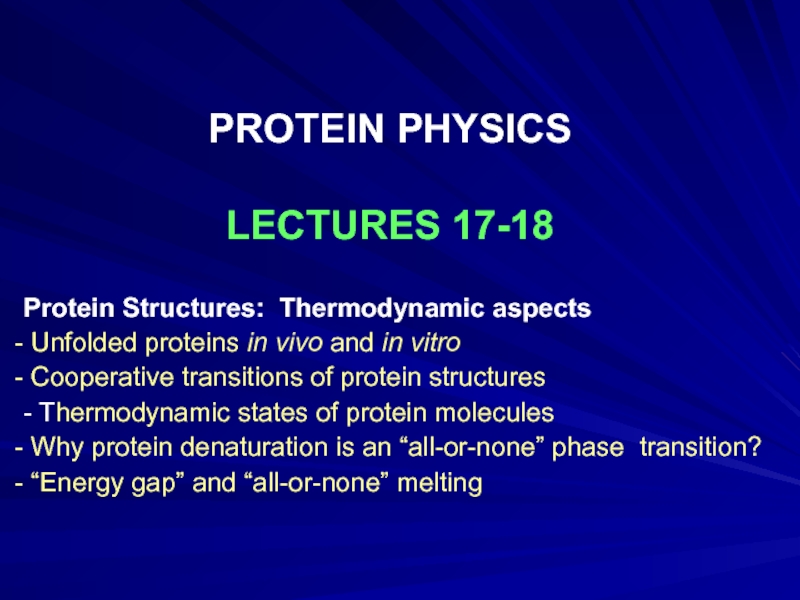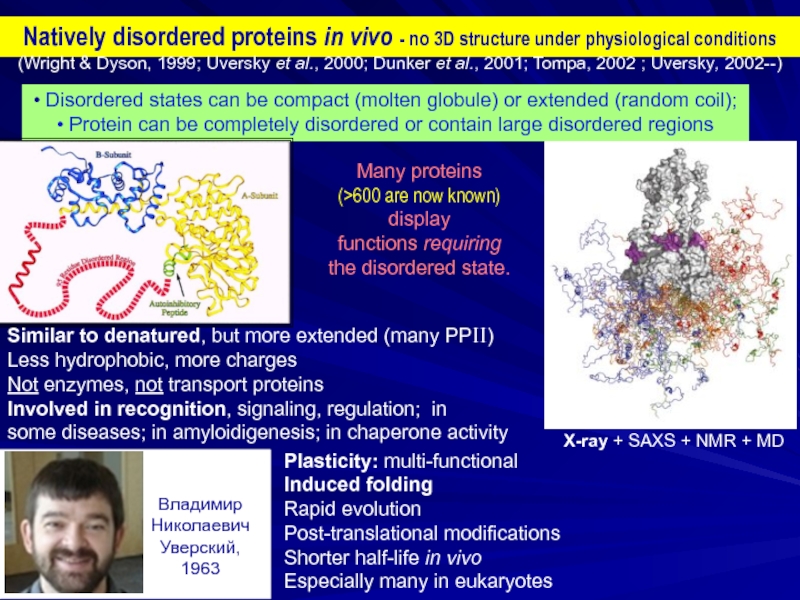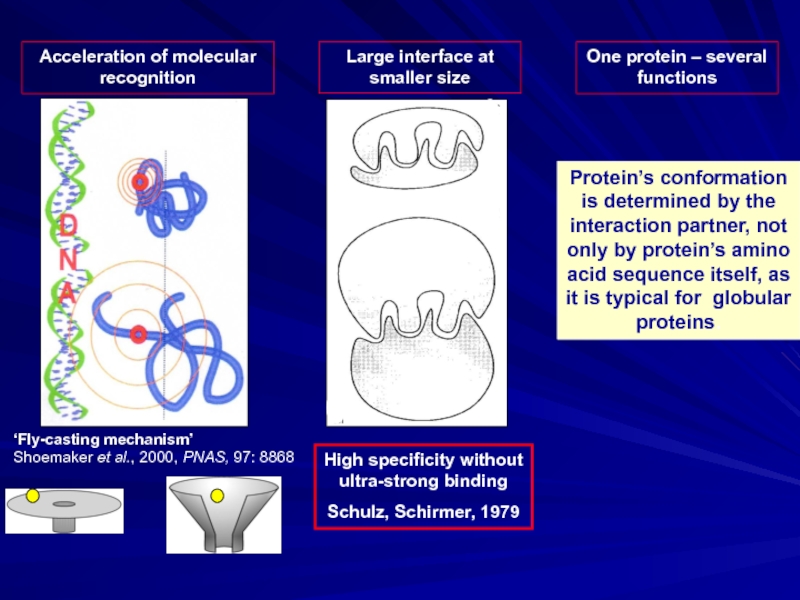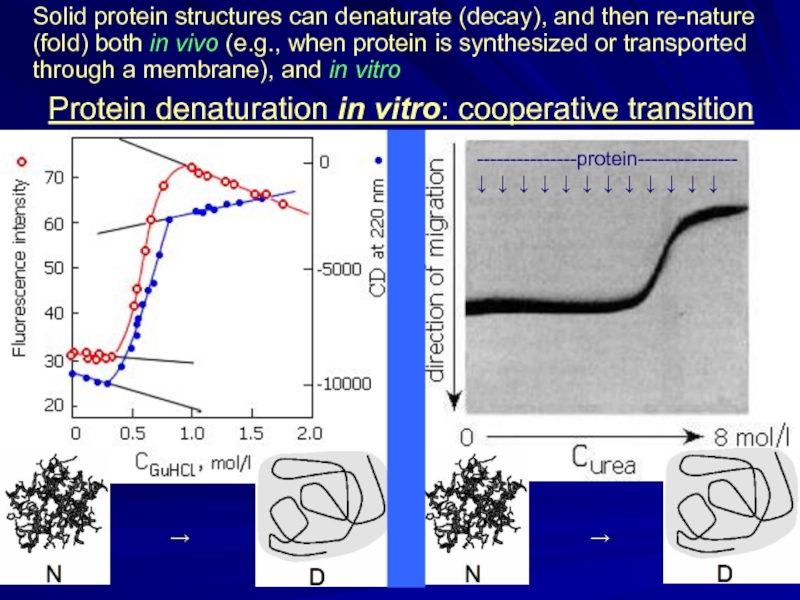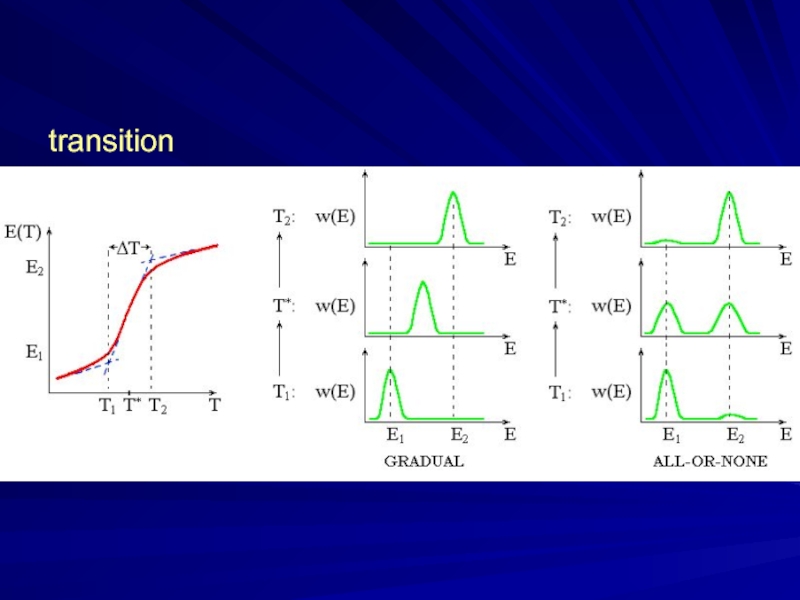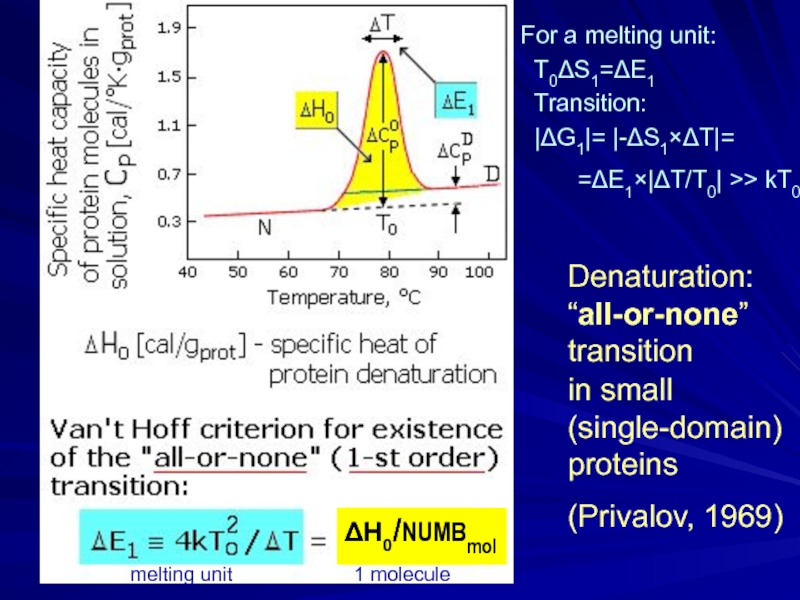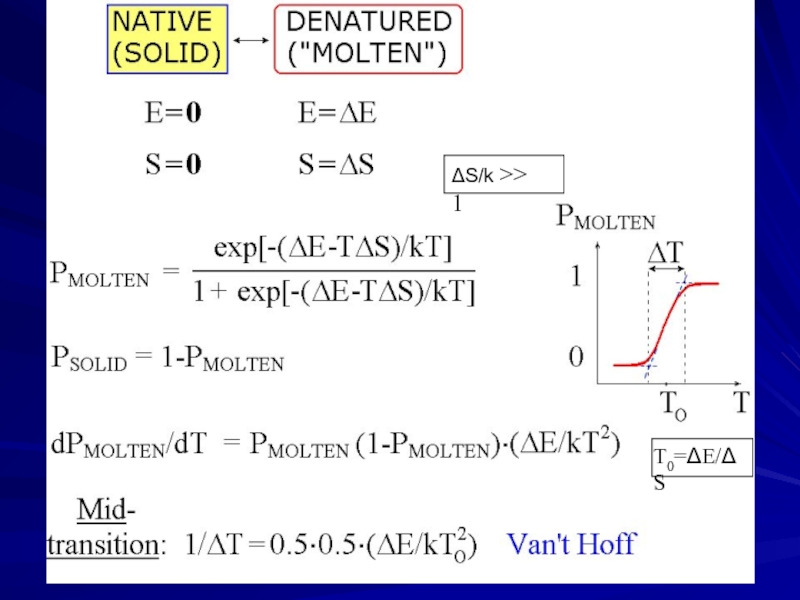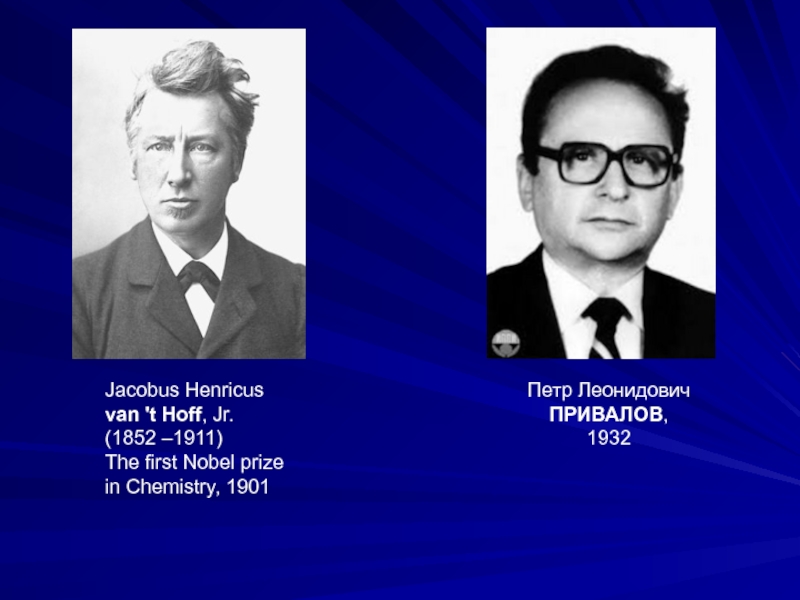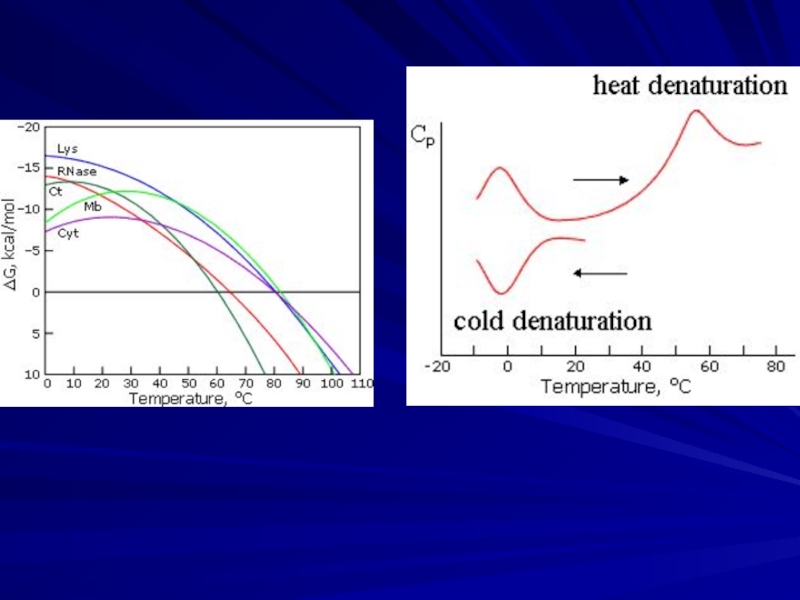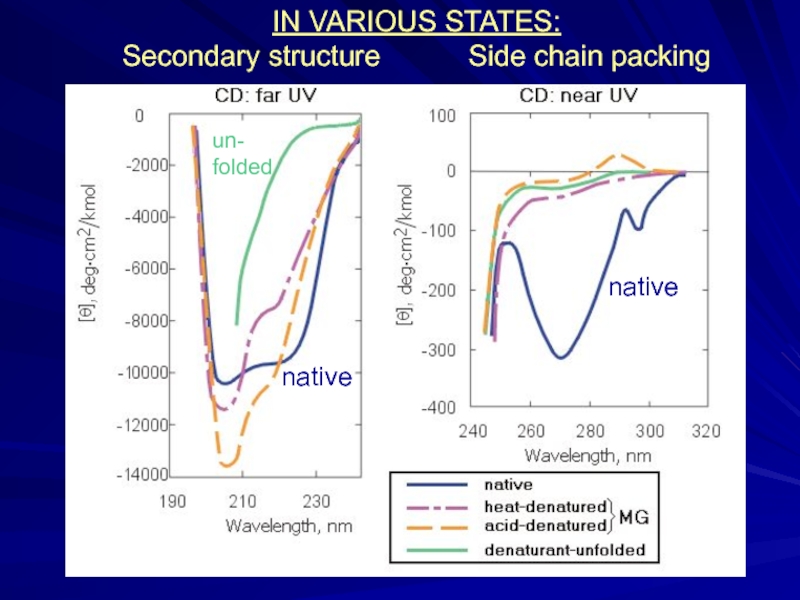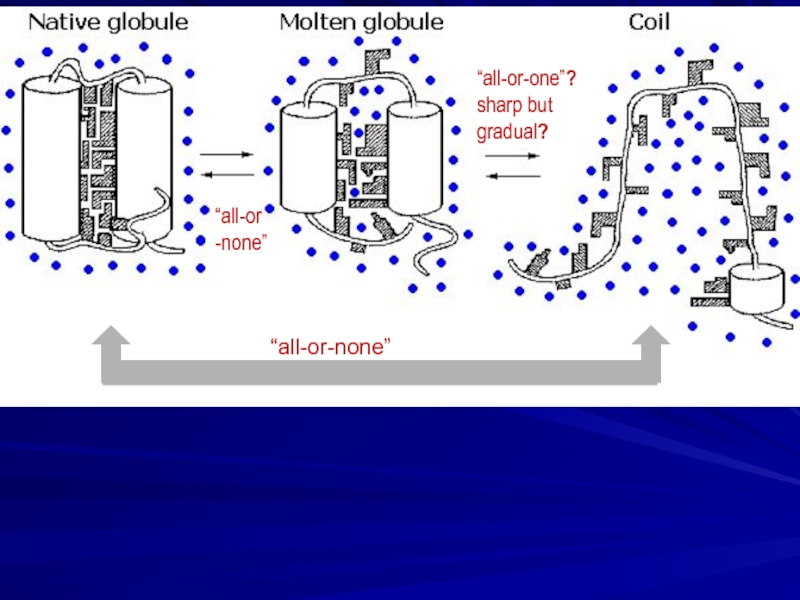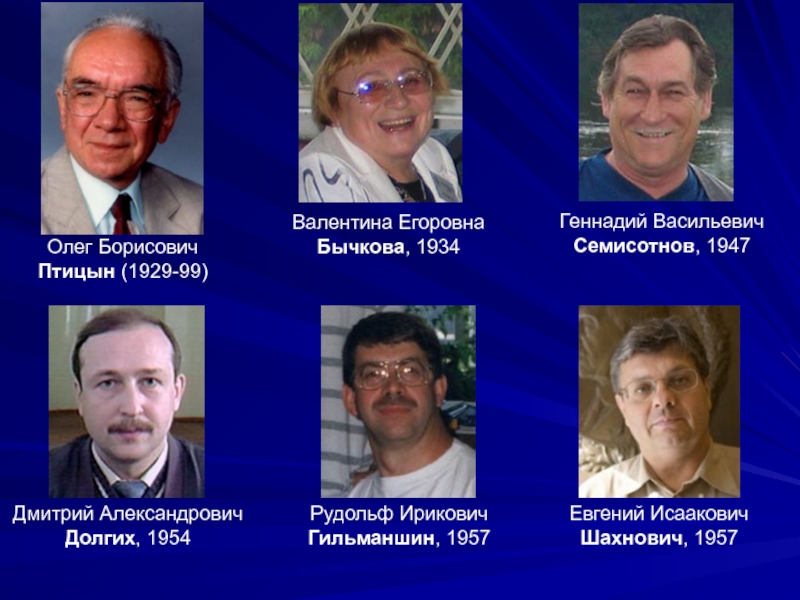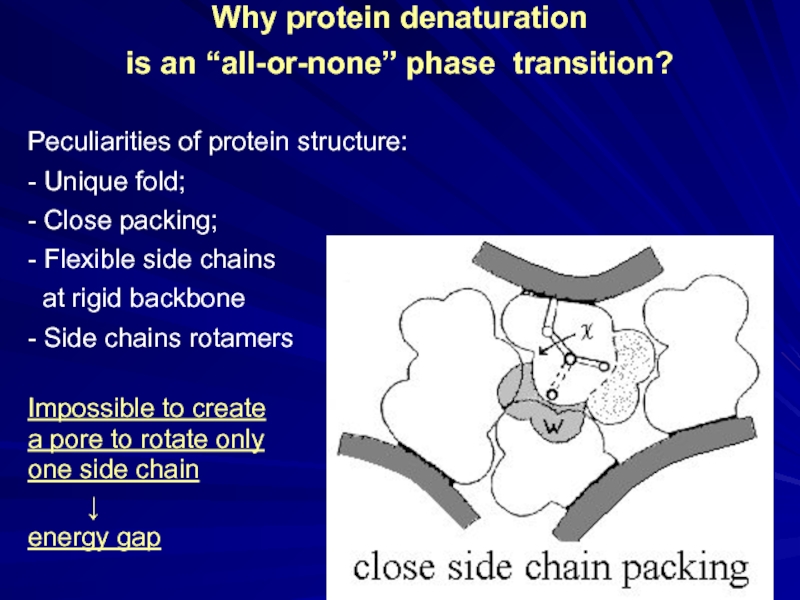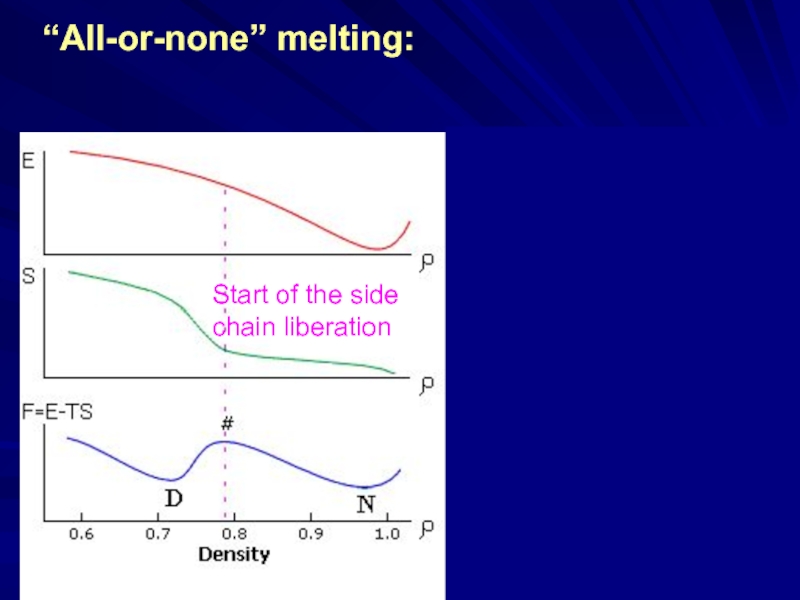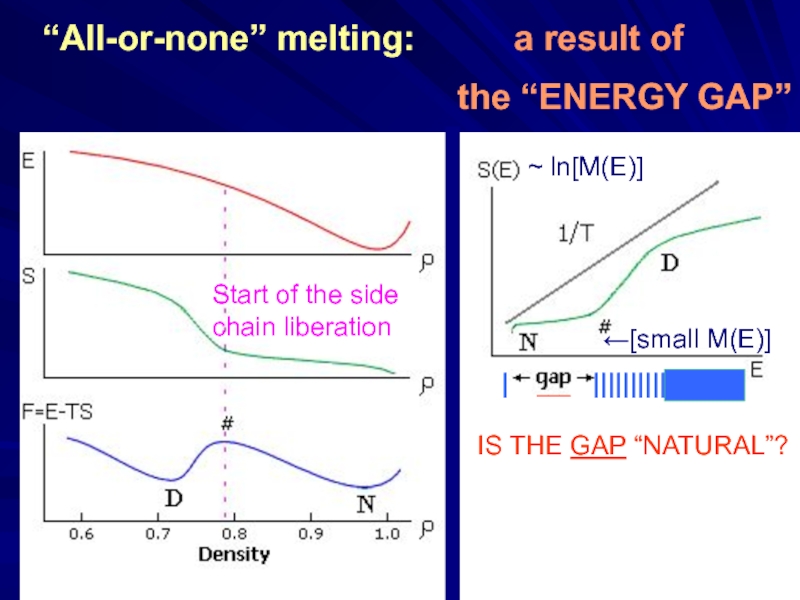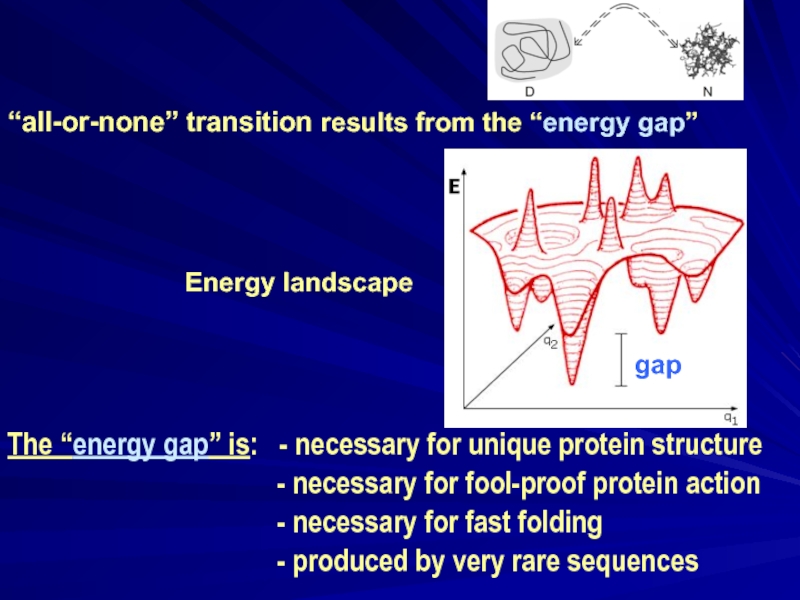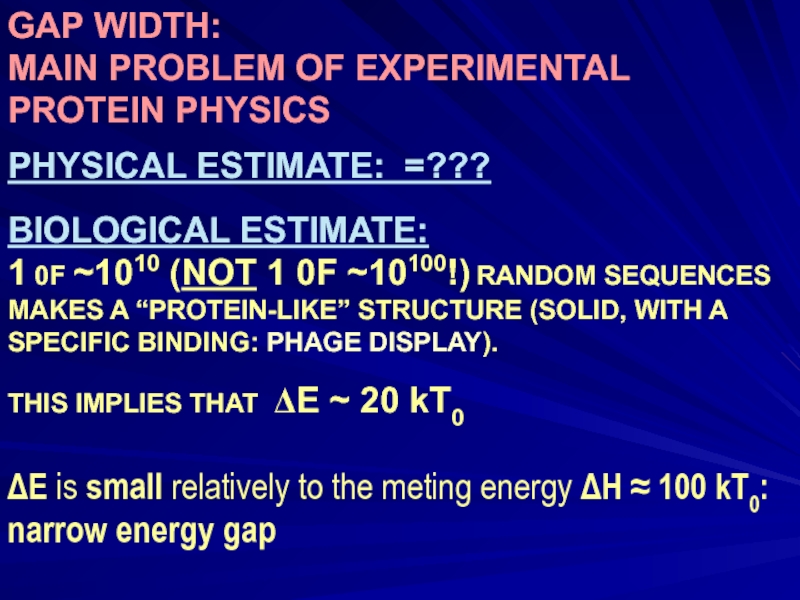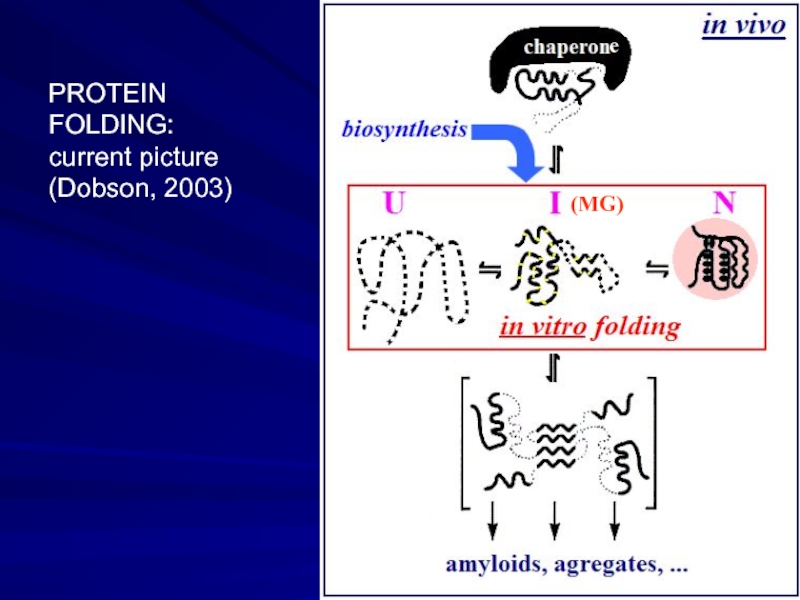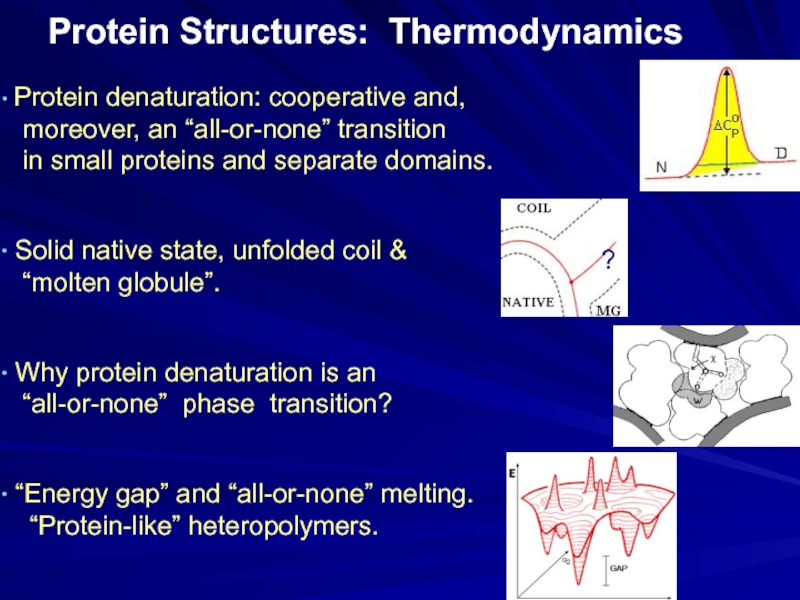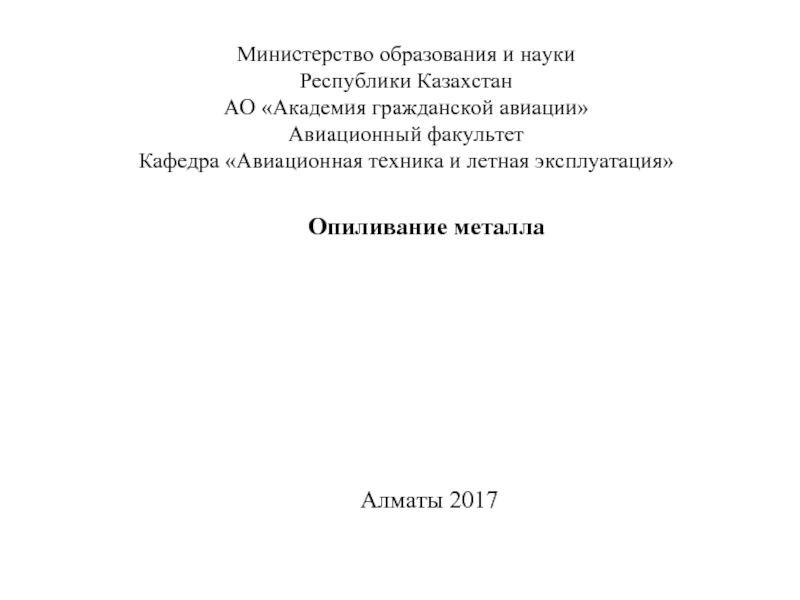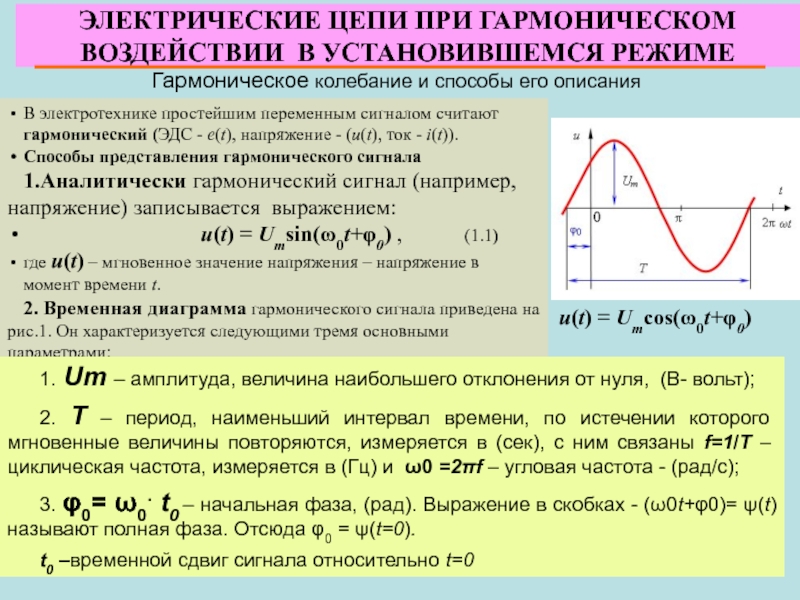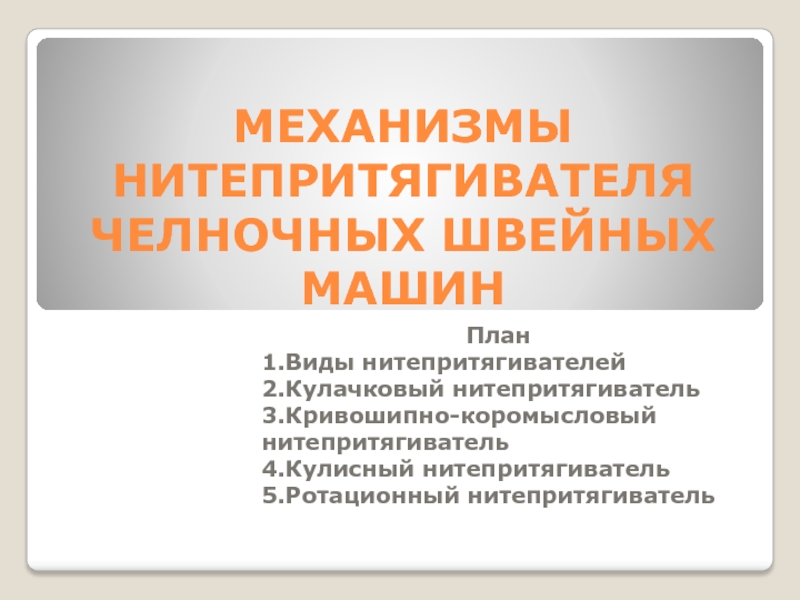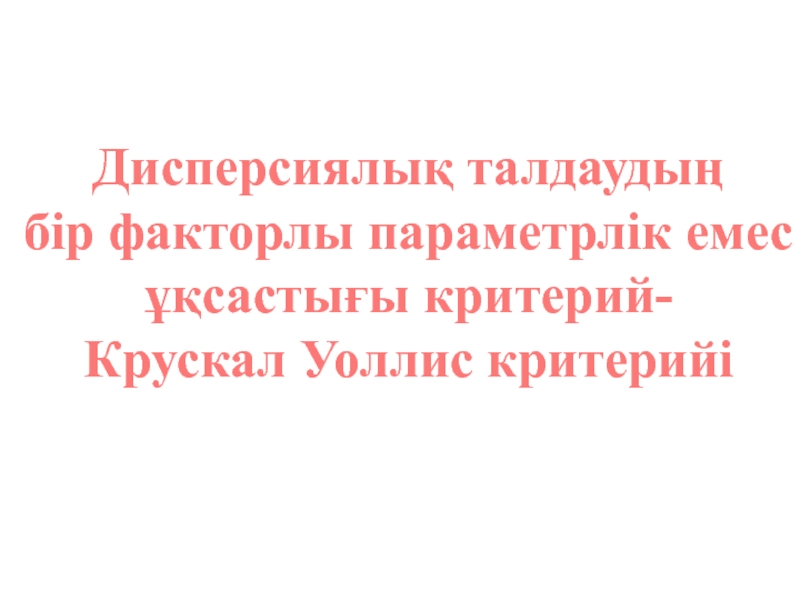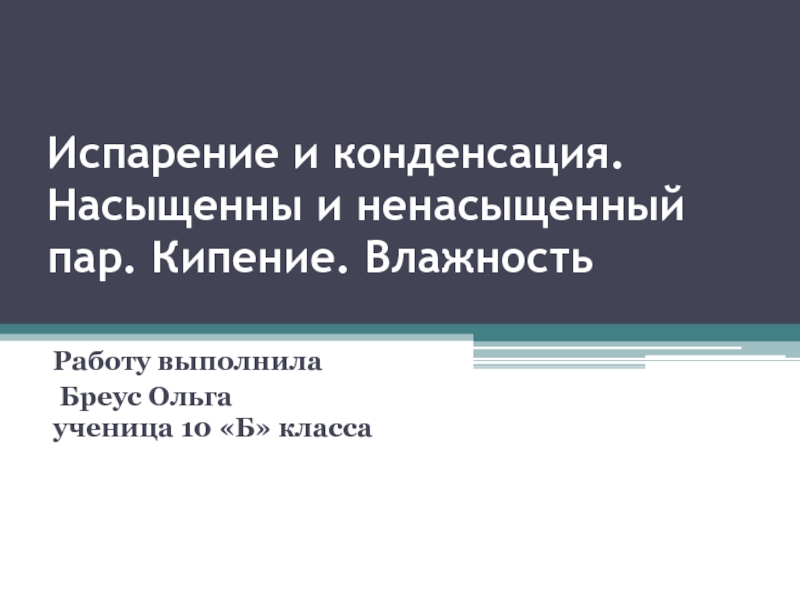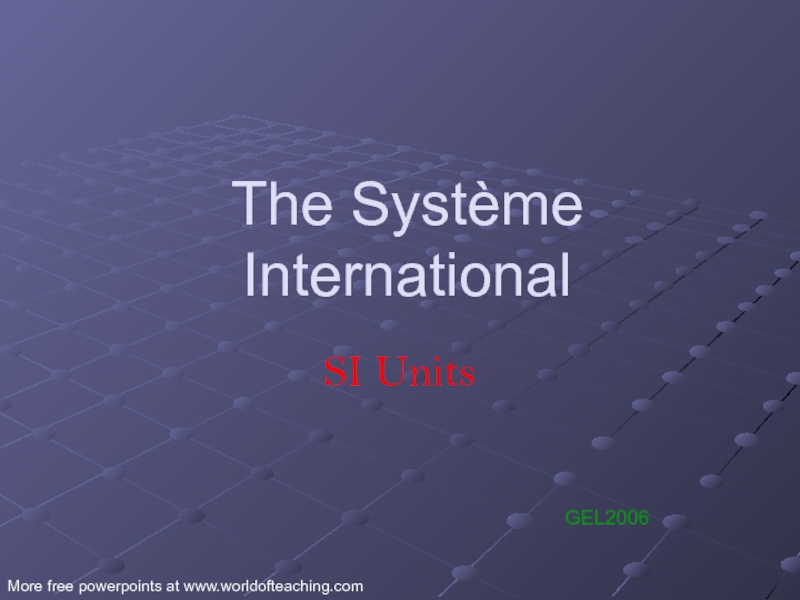- Главная
- Разное
- Дизайн
- Бизнес и предпринимательство
- Аналитика
- Образование
- Развлечения
- Красота и здоровье
- Финансы
- Государство
- Путешествия
- Спорт
- Недвижимость
- Армия
- Графика
- Культурология
- Еда и кулинария
- Лингвистика
- Английский язык
- Астрономия
- Алгебра
- Биология
- География
- Детские презентации
- Информатика
- История
- Литература
- Маркетинг
- Математика
- Медицина
- Менеджмент
- Музыка
- МХК
- Немецкий язык
- ОБЖ
- Обществознание
- Окружающий мир
- Педагогика
- Русский язык
- Технология
- Физика
- Философия
- Химия
- Шаблоны, картинки для презентаций
- Экология
- Экономика
- Юриспруденция
Protein Structures: Thermodynamic aspects презентация
Содержание
- 1. Protein Structures: Thermodynamic aspects
- 2. Natively disordered proteins in vivo - no
- 3. Acceleration of molecular recognition One protein –
- 4. Protein denaturation in vitro: cooperative transition
- 5. transition
- 6. Denaturation: “all-or-none” transition in small
- 7. ΔS/k >> 1 T0=ΔE/ΔS
- 8. Jacobus Henricus van 't Hoff, Jr.
- 10. “All-or-none” decay of native protein
- 11. IN VARIOUS STATES: Secondary structure
- 12. “all-or-none” “all-or -none” “all-or-one”? sharp but gradual?
- 13. Евгений Исаакович Шахнович, 1957 Дмитрий Александрович
- 14. Why protein denaturation is an “all-or-none”
- 15. Start of the side chain liberation
- 16. “All-or-none” melting: a
- 17. “all-or-none” transition results
- 18. GAP WIDTH: MAIN PROBLEM OF EXPERIMENTAL PROTEIN
- 19. e PROTEIN FOLDING: current picture (Dobson, 2003) (MG)
- 20. Protein Structures: Thermodynamics Protein
Слайд 1
PROTEIN PHYSICS
LECTURES 17-18
Protein Structures: Thermodynamic aspects
Unfolded proteins in vivo and
Cooperative transitions of protein structures
- Thermodynamic states of protein molecules
Why protein denaturation is an “all-or-none” phase transition?
“Energy gap” and “all-or-none” melting
Слайд 2Natively disordered proteins in vivo - no 3D structure under physiological
• Disordered states can be compact (molten globule) or extended (random coil);
• Protein can be completely disordered or contain large disordered regions
Many proteins
(>600 are now known)
display
functions requiring the disordered state.
(Wright & Dyson, 1999; Uversky et al., 2000; Dunker et al., 2001; Tompa, 2002 ; Uversky, 2002--)
X-ray + SAXS + NMR + MD
Similar to denatured, but more extended (many PPII)
Less hydrophobic, more charges
Not enzymes, not transport proteins
Involved in recognition, signaling, regulation; in
some diseases; in amyloidigenesis; in chaperone activity
Plasticity: multi-functional
Induced folding
Rapid evolution
Post-translational modifications
Shorter half-life in vivo
Especially many in eukaryotes
Владимир
Николаевич
Уверский,
1963
Слайд 3Acceleration of molecular recognition
One protein – several functions
Protein’s conformation is determined
‘Fly-casting mechanism’
Shoemaker et al., 2000, PNAS, 97: 8868
High specificity without ultra-strong binding
Schulz, Schirmer, 1979
Large interface at smaller size
Слайд 4
Protein denaturation in vitro: cooperative transition
Solid protein structures can denaturate (decay),
---------------protein---------------
↓ ↓ ↓ ↓ ↓ ↓ ↓ ↓ ↓ ↓ ↓ ↓
→
→
Слайд 6Denaturation: “all-or-none” transition
in small (single-domain) proteins
(Privalov, 1969)
For a melting
T0ΔS1=ΔE1
Transition:
|ΔG1|= |-ΔS1×ΔT|=
melting unit 1 molecule
=ΔE1×|ΔT/T0| >> kT0
ΔH0/NUMBmol
Слайд 8Jacobus Henricus
van 't Hoff, Jr.
(1852 –1911)
The first Nobel prize
in
ПРИВАЛОВ Петр Леонидович
ПРИВАЛОВ Петр Леонидович (р. 1932
ПРИВАЛОВ Петр Леонидович
ПРИВАЛОВ Петр Леонидович (р. 1932
Петр Леонидович
ПРИВАЛОВ,
1932
Слайд 10“All-or-none”
decay of native
protein structure:
Ensures reliability
and robustness
of protein
Solid native state, unfolded coil, “more compact molten state”
and cooperative transitions between them
(Tanford, 1968; Ptitsyn et al., 1981)
Слайд 13Евгений Исаакович
Шахнович, 1957
Дмитрий Александрович
Долгих, 1954
Геннадий Васильевич
Семисотнов, 1947
Олег
Птицын (1929-99)
Валентина Егоровна
Бычкова, 1934
Рудольф Ирикович
Гильманшин, 1957
Слайд 14Why protein denaturation
is an “all-or-none” phase transition?
Peculiarities of protein structure:
- Unique fold;
- Close packing;
- Flexible side chains
at rigid backbone
- Side chains rotamers
Impossible to create
a pore to rotate only
one side chain
↓
energy gap
Слайд 16“All-or-none” melting: a result of
the “ENERGY
Start of the side
chain liberation
~ ln[M(E)]
←[small M(E)]
IS THE GAP “NATURAL”?
| ___ ||||||||||||||||||
Слайд 17
“all-or-none” transition results from the “energy gap”
The “energy gap” is: - necessary for unique protein structure
- necessary for fool-proof protein action
- necessary for fast folding
- produced by very rare sequences
gap
Слайд 18GAP WIDTH:
MAIN PROBLEM OF EXPERIMENTAL PROTEIN PHYSICS
PHYSICAL ESTIMATE: =???
BIOLOGICAL ESTIMATE:
1 0F
THIS IMPLIES THAT ΔE ~ 20 kT0
ΔE is small relatively to the meting energy ΔH ≈ 100 kT0:
narrow energy gap
Слайд 20Protein Structures: Thermodynamics
Protein denaturation: cooperative and,
moreover, an
in small proteins and separate domains.
Solid native state, unfolded coil &
“molten globule”.
Why protein denaturation is an
“all-or-none” phase transition?
“Energy gap” and “all-or-none” melting.
“Protein-like” heteropolymers.
?
